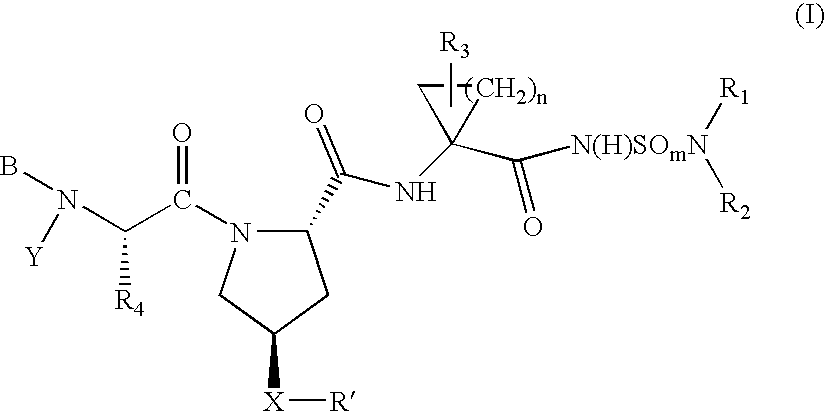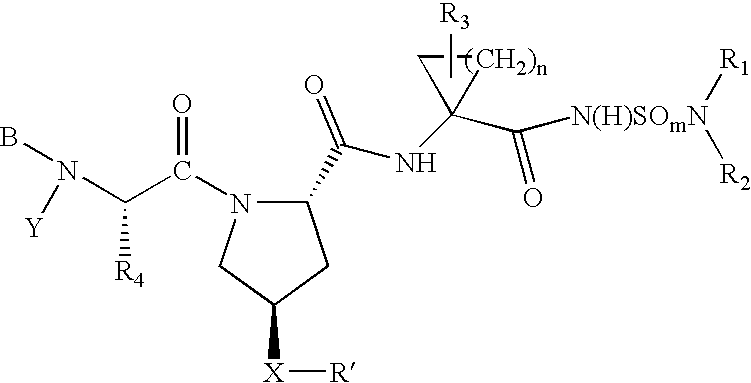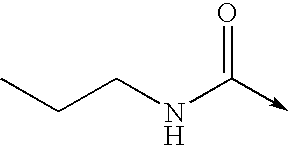Hepatitis C virus inhibitors
a technology of hepatitis c virus and inhibitors, which is applied in the field of antiviral compounds, can solve the problems of substantial fraction of patients not having a sustained reduction in viral load, and achieve the effect of inhibiting the function of ns3 proteas
- Summary
- Abstract
- Description
- Claims
- Application Information
AI Technical Summary
Benefits of technology
Problems solved by technology
Method used
Image
Examples
example 1
Preparation of 4-(Isoquinolin-1-yloxy)-pyrrolidine-1,2-dicarboxylic acid 1-tert-butyl ester
[0213]
A suspension of Boc-L-4-hydroxyproline (N-Boc (2S,4R)-hydroxyproline) (3.85 g 16.6 millimole (“mmol”) (CHEM-IMPEX International) in DMSO (60 mL) was cooled in an ice bath for ˜3 minutes, and then t-BuOK (4.66 g, 41.5 mmol) was added. Stirring and cooling in the ice bath was continued for a few minutes until a solid mass formed. At this time the reaction mixture was allowed to warm to rt over 1.5 h to give a clear colorless solution. 1-Chloroisoquinoline (3.0 g, 18.3 mmol) was added in two portions 10 min apart. The reaction was stirred for 24 h at rt. The dark reaction mixture was partitioned between ether (200 mL) and water (600 mL). The aqueous phase was acidified to pH 4 using 4N HCl. The resulting milky yellow solution was extracted with ether (4×200 mL). The combined ether extracts were dried (MgSO4), filtered, and concentrated in vacuo to give a golden oil. Flash chromatography (...
example 3
Preparation of P1 elements for incorporation into compounds of Formula
[0220] I. Preparation of racemic (1R,2S) / (1S,2R)-1-amino-2-vinylcyclopropane carboxylic acid ethyl ester hydrochloride (Method A and Method B)and chiral resolution of this racemate for the preparation of N-(1R, 2S)-1-amino-2-vinylcyclopropane carboxylic acid ethyl ester hydrochloride (Method C)
The named compound was made racemic by each of the following methods A and B. This racemate could also be resolved to afford chiral Boc-(1R, 2S)-1-amino-2-vinylcyclopropyl carboxylic acid ester which was deprotected under acid conditions to afford (1R, 2S)-1-amino-2-vinylcyclopropane carboxylic acid ester hydrochloride (Method C).
Method A
A.1 Preparation of N-Benzyl Imine of Glycine Ethyl Ester
[0221]
Glycine ethyl ester hydrochloride (303.8 g, 2.16 mole) was suspended in tert-butylmethyl ether (1.6 L). Benzaldehyde (231 g, 2.16 mole) and anhydrous sodium sulfate (154.6 g, 1.09 mole) were added and the mixture cooled t...
example 4
General procedure for the preparation of sulfamides
[0249]
The intermediate sulfamoyl chloride was prepared by addition of water (1 equiv) in THF to a cold (−20° C.) stirred solution of chlorosulfonyl isocyanate (1 equiv) in THF and the resulting solution allowed to warm to 0° C. To this solution was added anhydrous Et3N (1 equiv) followed by requisite secondary amine (1 equiv). The reaction mixture was warmed to room temperature, then filtered and the filtrate was rotary evaporated to afford the desired sulfamides.
PUM
| Property | Measurement | Unit |
|---|---|---|
| Current | aaaaa | aaaaa |
| Digital information | aaaaa | aaaaa |
| Pharmaceutically acceptable | aaaaa | aaaaa |
Abstract
Description
Claims
Application Information
 Login to View More
Login to View More - R&D
- Intellectual Property
- Life Sciences
- Materials
- Tech Scout
- Unparalleled Data Quality
- Higher Quality Content
- 60% Fewer Hallucinations
Browse by: Latest US Patents, China's latest patents, Technical Efficacy Thesaurus, Application Domain, Technology Topic, Popular Technical Reports.
© 2025 PatSnap. All rights reserved.Legal|Privacy policy|Modern Slavery Act Transparency Statement|Sitemap|About US| Contact US: help@patsnap.com



